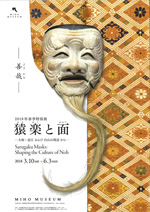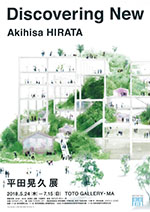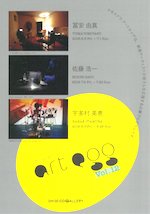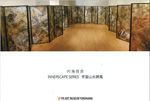 |
Picks is a monthly sampling of Japan's art scene, offering commentary by a variety of reviewers about exhibitions at museums and galleries in recent weeks, with an emphasis on contemporary art by young artists. |
 |
 |
|
|
 |
 |
|
| Sarugaku Masks: Shaping the Culture of Noh |
| 10 March - 3 June 2018 |
Miho Museum
(Shiga) |
 |
| As I gazed at one mask after another (350 were gathered here from various parts of Japan), I started to feel queasy. These are masks that were actually worn on the faces of flesh-and-blood actors, and therefore seem to have acquired a weird aura unlike anything exuded by paintings, sculptures or ceramics. Moreover, they are made of wood, an organic material closer to human flesh than stone or metal might be. Where the paint has peeled off, the masks resemble the crumbling visages of charred corpses. It was a spooky encounter. |
|
|
 |
|
The Rimpa School -- from Tawaraya Sotatsu to Tanaka Ikko |
12 May - 8 July 2018 |
Yamatane Museum of Art
(Tokyo) |
 |
| The Rinpa School was notable for a lineage that extended across time, place, and class, transmitting the decorative style of Tawaraya Sotatsu and Honami Koetsu to the 17th and 18th centuries via Ogata Korin and into the 19th century via Sakai Hoitsu. None of these men identified themselves as Rinpa artists; indeed, the appellation did not appear until the 20th century, as a postwar truncation of the Meiji-era term "Korin-ha." Picking the late graphic designer Ikko Tanaka as present-day heir to the Rinpa line makes sense, since he grasped the essence of Rinpa more fully than did any of his Nihonga artist contemporaries. |
|

|
 |
 |
|
|
|
 |
 |
| Akihisa Hirata: Discovering New |
| 24 May - 15 July 2018 |
TOTO Gallery Ma
(Tokyo) |
 |
| Hirata sees architecture as a "biological activity in the broad sense." Buildings undergo constant change at the hands of the people who occupy and utilize them, as well as from exposure to the elements. They are, in short, a type of ecosystem, and the job of the architect is to design spaces in which these diverse forces can intermingle. Organizing by concept Hirata's works over the past decade as well as ongoing projects, this show effectively gave viewers a glimpse into the architect's brain. |
|
|
|
|
 |
 |
 |
| Shiseido Art Egg 12: Yuma Tomiyasu Exhibition |
| 8 June - 1 July 2018 |
Shiseido Gallery
(Tokyo) |
 |
| This was a big installation. Opening a door at the bottom of a staircase, you found yourself in a darkened room with another door, which led to another room, and so on: the gallery had been subdivided into several chambers and corridors. Pictures on the walls jiggled and swayed; a TV set suddenly came to life; lights flickered on and off. The effect was of a child's nightmare, or a haunted house. Sad to say, it's been done before, making the impact less dramatic than intended.
|
|
|
|
|
|
|
 |
 |
| Nobuhiko Utsumi Exhibition |
| 5 - 16 June 2018 |
FEI Art Museum Yokohama
(Kanagawa) |
 |
| The centerpiece of this show was the 36-meter-long row of screen paintings covering 48 panels that comprise Utsumi's Innerscape 2016-18 Multiverse project. Utsumi composes his works by pouring sumi ink on a panel and blowing air to make the ink flow in complex liquid patterns. The method harkens back to Surrealism, but Usumi avers that his work is "nature itself manifesting the power of qi prized by the painters of ancient China," through which he "aims for a fierce countercurrent to Modernistic art." That may explain why he prefers folding screens to canvases -- but is there a narrative to be found on the panels?
|
|
 |
|
|
|
 |
|
|